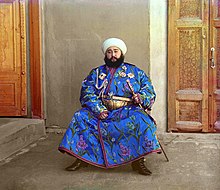Battle of Bukhara
| date | August 28 to September 2, 1920 |
|---|---|
| place | Bukhara |
| output | Soviet occupation of the territory, proclamation of the People's Republic of Bukhara |
| Parties to the conflict | |
|---|---|
|
Soviet Russia |
|
| Commander | |
| Troop strength | |
| 3,725 infantry 7,850 cavalrymen 20,000 armed civilians |
7,000 infantrymen 5,000 insurgents |
| losses | |
|
unknown |
unknown |

The Battle of Bukhara was the Russian Civil War , a conflict between the troops of the young Soviet Russia and those of the Emirate of Bukhara - they took from August 28 to September 2, 1920 in Bukhara instead.
prehistory
Domestically, the Emir of Bukhara was caught between two stools: the ubiquitous influence of the clergy and the Russian October Revolution of 1917, including reformists trained abroad. In April 1917 a congress of the Muslims of Turkestan met in Tashkent to discuss the future of Central Asia.
The Soviet Commissariat under Fyodor Kolessov launched an attack on Bukhara in 1918, which, like Khiva, was negotiating with London to place itself under the British protectorate instead of the previous Russian one. But despite Soviet successes, such as the plundering of the Emir's second treasury when a fortress was conquered, the attack was broken off on March 25, 1918, and Kolessov feared the general uprising propagated by the clergy. On April 30, 1918, the Soviets recognized the emirate as ASSR Turkestan .
Inside, Fajzullah Chodscha , a radical reformer with excellent contacts to the Soviets and the second richest man in Bukhara (after the emir), organized the resistance against the emir. He intended cultural and social reforms.
The battle
In 1920 the rather insignificant "Communist Party of Bukhara", led by Chodscha, took up arms and on August 29, 1920 asked the Soviets for help, who rushed to support the "working people of the emirate". Michail W. Frunze sent 7,000 infantry , 2,500 cavalry , 5 armored trains , 40 artillery pieces and 11 aircraft to Bukhara, the “communists” of the emirate allegedly had 5,000 infantry and 2,000 cavalry. On the Emir's side were 8,700 infantry and 7,500 cavalry, plus allegedly 27,000 irregular fighters.
In the Battle of Bukhara on August 28, 1920, troops from both sides met. The fighting lasted until September 2nd, the emir lost and fled to Afghanistan.
Bukhara People's Republic
On October 18, 1920, the Socialist People's Republic of Bukhara was proclaimed, and Fajzullah Chodscha claimed the title of "Chairman of the Council of Ministers" for himself. However, the government lacked the cadres to implement reforms; it had to rely on the emir's old elites, who were accordingly little interested in the reforms. Added to this was the fear of not violating religious and social traditions. The government lost the support of the poor again.
In the east of the country, the ousted Emir Said Alim Khan rallied fighters against the Soviets with British help, but was driven back to Afghanistan by the Red Army in early 1921.
At the end of 1921 his followers crossed the border again and allied themselves with the Basmati and Enver Pasha . Enver, appointed by Alim Khan as "Commander in Chief of the Armed Forces of Islam and Governor of the Emir of Bukhara", conquered Dushanbe and occupied the whole of eastern Bukhara (Tajikistan), but was defeated by the Soviets in the summer of 1922 and fell in battle.
On March 4, 1921, the People's Republic of Bukhara was recognized as independent in an alliance treaty between Bukhara and the Soviet Union.
literature
- The Red Army in Turkestan 1917-1920 , in: Central Asian Review, 1965, No. 1, pp. 31-43.